India has a vibrant and diverse newspaper industry with hundreds of publications in multiple languages. Newspapers play an important role in providing information, shaping public opinion, and holding the government and powerful interests accountable. The Indian newspaper industry has witnessed major growth over the past few decades with increasing literacy levels, proliferation of media, and technological advancements allowing for wider reach.
The Top 10 Newspapers in India
| S.No. | Newspapers in India |
| 1 | Dainik Jagran |
| 2 | Dainik Bhaskar |
| 3 | The Times Of India |
| 4 | Amar Ujala |
| 5 | Hindustan Times |
| 6 | Malayala Manorama |
| 7 | Dainik Navjyoti |
| 8 | Eenadu |
| 9 | Rajasthan Patrika |
| 10 | Daily Thanthi |
1. Dainik Jagran
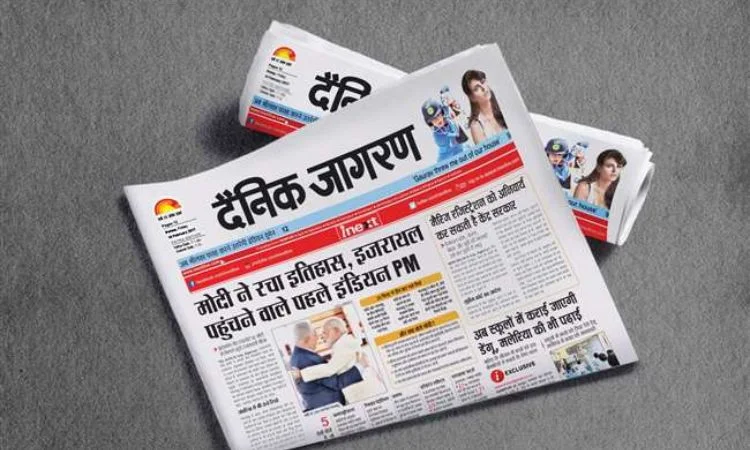
Source: Dainik Jagran
Dainik Jagran is the most widely read newspaper in India with a total readership of over 55 million. Established in 1942, it covers national and international news along with extensive local coverage. It is known for its city-centric supplements and local cartoons. Headquartered in New Delhi, Dainik Jagran publishes 37 editions across 14 states covering key regions of Uttar Pradesh, Uttarakhand, Delhi NCR, Bihar, Jharkhand, Madhya Pradesh, Chhattisgarh, Punjab, Haryana, Himachal Pradesh, Jammu & Kashmir and Odisha among others.
Its USP lies in hyperlocal coverage across these geographies with 150 add-ons catering to specific cities, towns, and local demands. It carries 16-page supplements focused on niche subjects like education, jobs, technology, automobiles, etc. Some of its most-read columns have been satirical political sketches and cartoons, helping it resonate with the grassroots population along with national issues.
2. Dainik Bhaskar
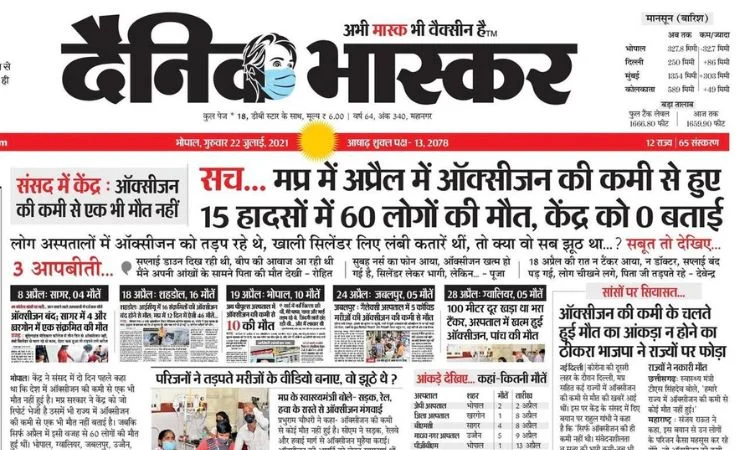
Source: Dainik Bhaskar
With over 33 million readers, Dainik Bhaskar is the second most-read newspaper in India across Hindi markets. Launched in 1958, it has editions in Madhya Pradesh, Chhattisgarh, Rajasthan, Haryana, Punjab, and Chandigarh as well as urban centers like Delhi NCR. It is owned by the D B Corp Ltd. Over the past decades, Dainik’s Bhaskar’s major focus has been connecting with ‘Bharat’ – the semi-urban and rural broader population across India’s Hindi heartland.
It customized editorials and supplements for different Tier-2 and Tier-3 cities focusing intensely on reader linkages. This hyperlocal content strategy combined with on-ground activities helped create top-of-the-mind visibility and trust accelerating its growth faster than rivals. As its young readers in smaller towns upgrade, Dainik Bhaskar hopes to retain connections with perspectives nurtured by on-ground teams across geographies.
3. The Times of India
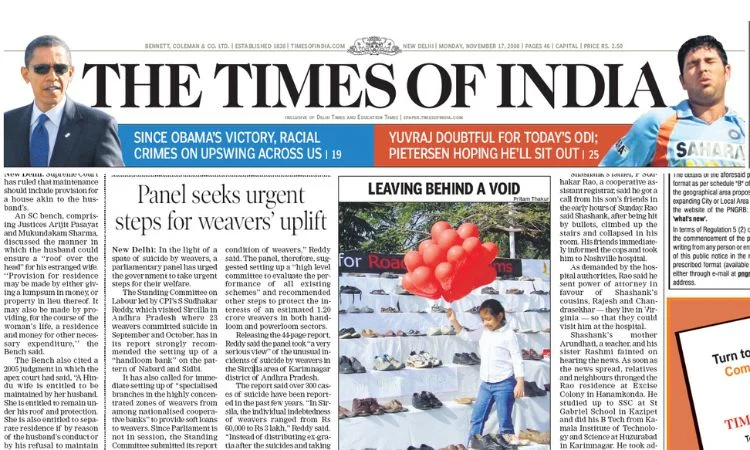
Source: Google
Published by The Times Group, The Times of India is the largest English daily in India with over 7.6 million readers. In publication since 1838 during the British rule, it has grown to be the third-largest circulating daily in the country. Headquartered in Mumbai with editions in all major cities, it covers national and international news primarily targeting urban upscale audiences.
Times of India editorial focuses on governance, politics, and policies at the national level with strong opinion pieces from subject experts. In-depth special coverage is done around important news events. It also has dedicated weekend content targeted at readers’ lifestyle interests including entertainment and sports. Over the years, TOI implemented key brand-building initiatives like city-specific tabloid supplements, pull-out customized content, and strategic partnerships expanding its affluent upper-middle-class readership base nationally.
4. Amar Ujala
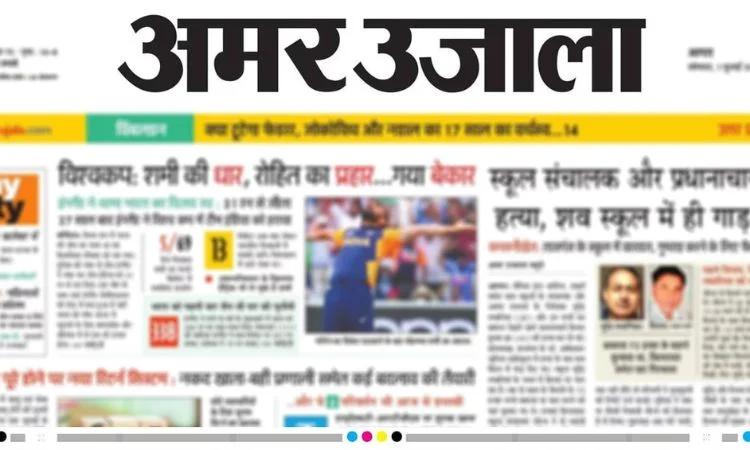
Source: Amar Ujala
Amar Ujala is another leading Hindi daily published from multiple centers across northern India including Delhi, Haryana, Punjab, Himachal Pradesh, Jammu and Kashmir, and Uttarakhand. Launched in 1948, it currently has around 6.7 million readers owing to its localized content across geographies, with a special focus on rural coverage.
Over 70% of Amar Ujala’s content gets created by its on-ground reporting network tuned into the public pulse combined with supplements that resonate with the target readers including sections on agriculture, career, entertainment gossip, and women’s issues among others. Through its mass-market reach strategy anchored in the language connecting rural North India, Amar Ujala has emerged as a leading Hindi voice from the region.
5. Hindustan Times
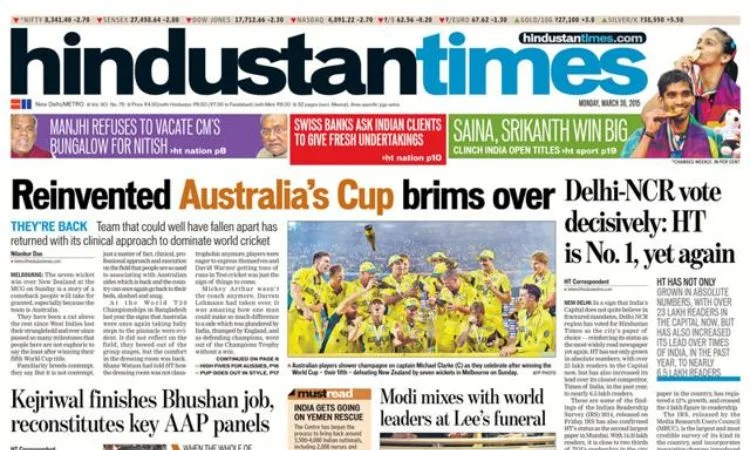
Source: Hindustan Times
Owned by HT Media Ltd, Hindustan Times is one of the big English dailies catering to over 6.2 million readers pan-India. Started in 1924 during the freedom movement, it has a strong legacy. Headquartered in New Delhi, its key regions include Delhi NCR, West Bengal, Odisha, Jharkhand, Bihar, and Uttarakhand catering to both urban and semi-urban audiences with an emphasis on politics and business coverage.
Over the years, Hindustan Times implemented key innovations in presentation, design, and interactive interfaces to appeal to younger upwardly mobile Indians from tier-1,2 towns and enhance engagement across age groups. Alongside print leadership in North India, its digital properties like LiveHindustan.com in vernacular and local languages have reported robust growth benefiting the parent media group. The long-term aim is to retain heritage readers while reinventing content mediums to find new audiences.
6. Malayala Manorama
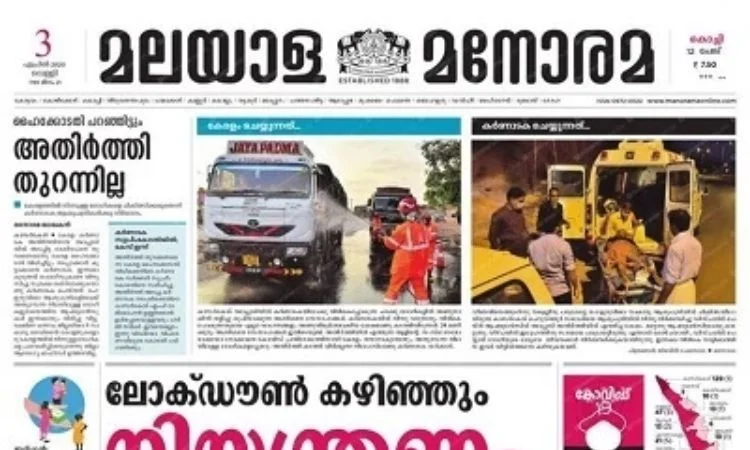
Source: Services Media
With over 6.1 million readers, Malayala Manorama is the leading daily in Malayalam primarily catering to Kerala as well as border districts of Tamil Nadu and Karnataka along with the Gulf diaspora. Founded in 1890, the family-promoted newspaper is headquartered in Kottayam covering politics, business, entertainment, and more with a focus on presenting news relevant to the local community perspective.
The editorial focus is presenting news, perspectives, and interpretations centered around issues relevant to the citizens of Kerala including politics, businesses, entertainment, and societal issues. While news bureaus in major districts ensure extensive coverage of hyperlocal news daily, various special weekly supplements cater to niche segments ranging from human interest, gender, and agriculture to applications of new technology.
Malayala Manorama over the past century has emerged as one of the most credible and influential regional language dailies in India with readership spanning across Kerala state and also border areas of neighboring Tamil Nadu and Karnataka.
7. Dainik Navajyoti
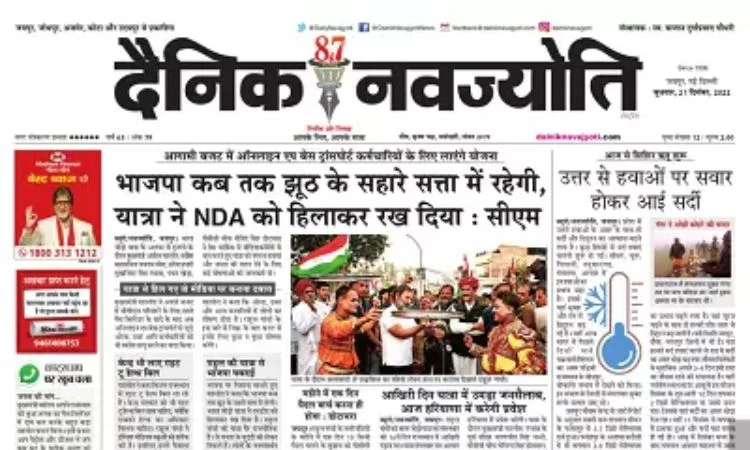
Source: Services Media
Dainik Navajyoti is a leading Hindi daily published by the Jagran Prakashan Group with over 5 million total readers. Established in 1953 in Meerut, Uttar Pradesh, it started as a regional newspaper for Western UP and Delhi NCR, before expanding over the next few decades to other neighboring states.
Headquartered in New Delhi as part of the group’s mainstream newspapers portfolio, key regions under coverage by Dainik Navajyoti are Uttar Pradesh, Uttarakhand, Himachal Pradesh, Punjab, Haryana, Delhi NCR and Jammu & Kashmir – primarily Tier 2 and 3 towns across the Hindi belt. It publishes multiple city-specific editions from 25 printing press centers allowing localized coverage for cities like Agra, Bareilly, Varanasi, Amritsar, and Chandigarh among others.
Carrying the credibility of the Jagran brand name plus understanding the concerns of the Hindi heartland population – Dainik Navajyoti established itself among the most read options from the region beyond metros.
8. Eenadu
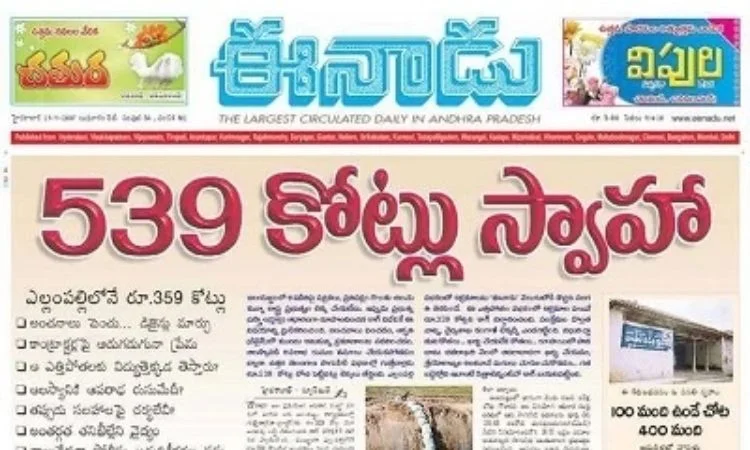
Source: Services Media
The largest circulated Telugu newspaper in India and the eighth-largest nationally, Eenadu was founded in 1974 by Ramoji Rao. With over 5 million readers across Andhra Pradesh and Telangana, this Hyderabad-headquartered newspaper is known to have brought credibility through independent reporting during the Emergency. It provides extensive coverage of politics, films, and sports along with bustling news bureaus across districts and mandals in the two states getting hyperlocal news.
Eenadu expanded its portfolio with forays into television, and print publications in other Indian languages besides making measured digital moves recognizing the medium shift in news consumption among next-gen audiences. However, at its core, the legacy newspaper publication continues bringing grassroots stories packaged attractively through a trustworthy native voice.
With its continued dominance across Andhra Pradesh and Telangana fuelling the growth of Ramoji Rao’s sizeable media empire, Eenadu aims to drive innovations setting industry benchmarks.
9. Rajasthan Patrika
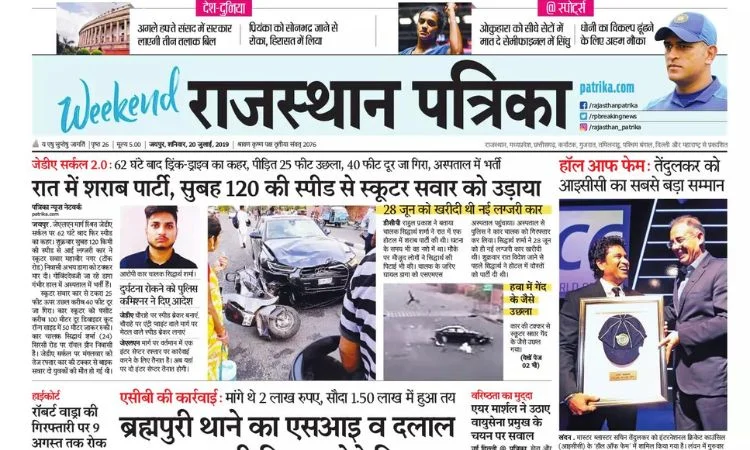
Source: X.com
Started in 1956, Rajasthan Patrika is a leading vernacular daily from the Patrika Group with over 4.7 million total readers across north Indian states like Rajasthan, Punjab, Haryana as well as Delhi NCR. Published in Hindi from Delhi, Jaipur, Jodhpur, and several other centers, it has widespread offering localized print editions to connect with grassroots readers in semi-urban and rural regions across coverage areas along with reporting on national developments.
Over the decades, editions were launched from Jaipur, Jodhpur, and other districts of Western Rajasthan before expanding its imprint beyond the state by the 1990s to cater to Hindi readership in emerging Tier 2/3 towns across North India. It pioneered the concept of decentralized printing enabling wider reach and penetrating remote rural areas with hyperrelevant content unlike other newspapers controlled from metro cities.
While political analysis and national issues get due coverage, Rajasthan Patrika’s differentiated positioning is providing a voice to the heartland population ignored by English mainstream media. Recent digital initiatives around news videos and vernacular platforms have enhanced its appeal among young Indians as an authentic brand representing their aspirations beyond metros.
10. Daily Thanthi
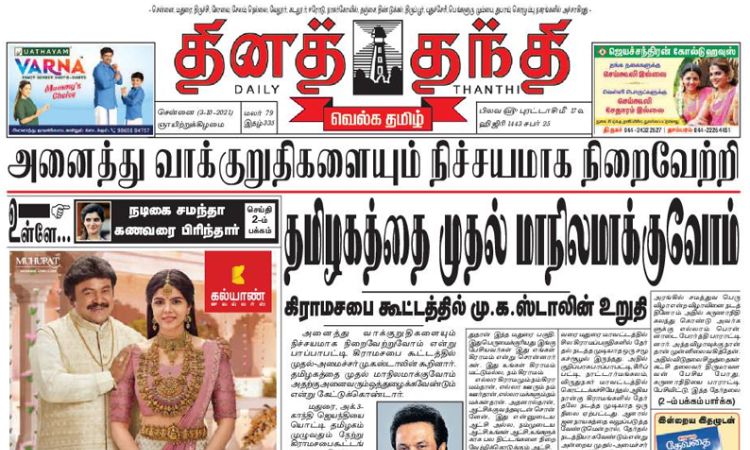
Source: X.com
With origins dating back to 1942, Daily Thanthi is a reputed Tamil newspaper headquartered in Chennai. Over generations, it has emerged as one of the most-read dailies with over 4.6 million readers across Tamil Nadu and bordering areas. Owned by Thanthi Group, its unique selling proposition is its editorial style presenting news and perspectives keeping local population interests in mind by having native speakers as bureau heads across districts.
Daily Thanthi’s differentiated style of journalism puts local flavor at the center of news coverage, presentation, and narratives on public discourse. The organization structure has bureau chiefs who are native Tamil speakers heading operations in each district to drive hyperlocal coverage. This results in a strong emphasis on happenings in towns & villages beyond the capital Chennai with dedicated state-wide features highlighting the latest developments, human interest stories, and problems affecting daily lives and profiling noteworthy achievements concerning common citizens.
Supplements focus on issues like agriculture, rural developments, and literature while visual storytelling approaches add color. Digital media expansions have enabled Daily Thanthi to attract youth readership.
Conclusion
The top 10 newspapers in India have widespread reach and influence across different regions, languages, and urban-rural geographies. Ranging from legacy English newspapers to indigenous vernacular dailies, these publications have carved a distinct niche through content that resonates with their target readers. With increasing literacy and competition, the landscape will continue to evolve further.














